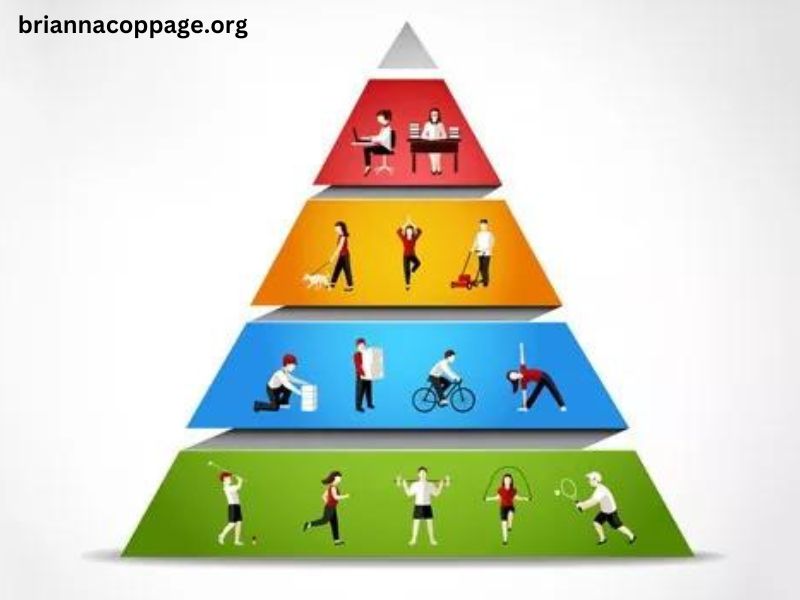Physical activity is essential for maintaining health and wellness. It encompasses a variety of movements and exercises that contribute to physical fitness, mental well-being, and overall quality of life. The Physical Activity Pyramid is a valuable tool designed to help individuals understand the different types of physical activities and their recommended frequencies. At the base of this pyramid lies lifestyle activities, which are crucial for promoting an active lifestyle. This article will delve into where lifestyle activities fit within the Physical Activity Pyramid, their importance, types, and practical tips for incorporating them into daily life.
Understanding the Physical Activity Pyramid
The Physical Activity Pyramid is a visual representation that categorizes physical activities into four distinct levels. Each level highlights different types of activities, emphasizing their frequency and intensity. The pyramid typically consists of the following sections:
- Lifestyle Activities (Base Level)
- Aerobic Activities (Second Level)
- Strength Activities (Third Level)
- Flexibility Activities (Top Level)
1. Lifestyle Activities: The Foundation
At the base of the Physical Activity Pyramid are lifestyle activities, which include daily movements and tasks that individuals perform as part of their routine. These activities are often low-intensity and can be easily integrated into everyday life. Examples include walking, gardening, cleaning, and even playing with children.
The foundation of the pyramid signifies that lifestyle activities are essential for overall physical activity levels. The goal is to encourage individuals to be active throughout the day rather than relying solely on structured exercise sessions.
Importance of Lifestyle Activities
Lifestyle activities serve several crucial purposes:
- Accessibility: They can be performed by people of all ages and fitness levels, making them inclusive and attainable.
- Consistency: Engaging in these activities regularly can help establish a routine of movement, contributing to overall physical health.
- Caloric Expenditure: While individual sessions may not be high in intensity, accumulated lifestyle activities throughout the day can contribute significantly to daily caloric expenditure.
- Mental Health Benefits: Engaging in simple physical activities can enhance mood, reduce stress, and promote mental well-being.
- Social Interaction: Many lifestyle activities involve social components, such as walking with a friend or playing with children, which can enhance social connections and improve mental health.
2. Types of Lifestyle Activities
Lifestyle activities are diverse and can vary greatly depending on individual preferences, environments, and daily routines. Some common categories include:
- Walking: Walking is one of the easiest and most accessible forms of physical activity. It can be integrated into daily tasks such as commuting, shopping, or walking pets.
- Household Chores: Activities such as vacuuming, gardening, and yard work involve movement and can contribute to physical fitness.
- Active Transportation: Biking or walking instead of driving, especially for short trips, adds valuable physical activity to daily routines.
- Recreational Activities: Engaging in leisure activities like dancing, playing sports casually, or participating in community events can also be considered lifestyle activities.
- Play: Activities that involve children, such as playing tag, flying kites, or even participating in outdoor games, contribute to physical activity levels.
3. Recommendations for Lifestyle Activities
The U.S. Department of Health and Human Services recommends that adults engage in at least 150 minutes of moderate-intensity aerobic activity per week, along with muscle-strengthening activities on two or more days. While structured exercise is important, integrating lifestyle activities can help individuals meet these recommendations more easily.
Here are some practical tips for incorporating lifestyle activities into daily life:
- Walk More: Opt for walking instead of driving for short trips. Consider parking farther away from destinations to increase your steps.
- Take the Stairs: Whenever possible, choose stairs over elevators or escalators.
- Incorporate Movement into Chores: Turn cleaning and household tasks into an opportunity for physical activity. Play music and dance while doing chores to make them more enjoyable.
- Plan Active Family Time: Organize family outings that involve physical activity, such as hiking, biking, or playing sports.
- Use a Standing Desk: If your job involves long periods of sitting, consider using a standing desk or taking breaks to stretch and move around.
The Role of Aerobic and Strength Activities
While lifestyle activities serve as the foundation of the Physical Activity Pyramid, they should not be the only form of physical activity engaged in. The second and third levels of the pyramid include aerobic activities and strength activities, respectively.
Aerobic Activities
Aerobic activities are higher in intensity and involve sustained physical effort. They are crucial for improving cardiovascular fitness and endurance. Common examples include:
- Running or jogging
- Cycling
- Swimming
- Dancing
- Group fitness classes
Strength Activities
Strength training involves using resistance to improve muscle strength and endurance. This type of exercise is essential for maintaining muscle mass, supporting metabolic health, and enhancing overall physical function. Examples include:
- Weightlifting
- Bodyweight exercises (e.g., push-ups, squats)
- Resistance band exercises
- Pilates
Integrating All Levels of the Pyramid
For optimal health, it is essential to integrate all levels of the Physical Activity Pyramid. While lifestyle activities lay the groundwork, they should be complemented by regular aerobic and strength training exercises.
Creating a Balanced Routine
To create a balanced routine that incorporates lifestyle activities along with aerobic and strength training, consider the following strategies:
- Set Realistic Goals: Start with small, achievable goals for incorporating lifestyle activities. Gradually build up to include more structured aerobic and strength training sessions.
- Schedule Activity: Just as you would schedule a meeting or appointment, set aside time for structured aerobic and strength training workouts. Balance these sessions with lifestyle activities throughout the week.
- Stay Flexible: Life can be unpredictable. Be adaptable in your approach to physical activity. If a planned workout gets derailed, look for opportunities to integrate lifestyle activities instead.
- Monitor Progress: Use a journal or app to track your physical activity levels. This can help motivate you and identify areas for improvement.
- Find Enjoyment: Choose activities that you genuinely enjoy. This will make it easier to stick with your routine and help you remain active.
Conclusion
Lifestyle activities occupy a fundamental role in the Physical Activity Pyramid, serving as the base upon which a healthy and active lifestyle is built. They are accessible, easily integrated into daily life, and play a crucial role in enhancing overall health and well-being. By incorporating lifestyle activities alongside aerobic and strength training, individuals can create a balanced and sustainable approach to physical activity.
Encouraging the adoption of lifestyle activities can help combat sedentary behavior, promote physical fitness, and improve mental health. As we strive to lead healthier lives, recognizing and valuing the importance of lifestyle activities can be the first step toward a more active and fulfilling life. Whether it’s a leisurely walk, gardening, or engaging in playful activities with family, every bit of movement counts in fostering a culture of health and wellness. So, let’s embrace lifestyle activities as the foundation of our physical activity journey and strive to make movement a joyful part of our everyday lives.






